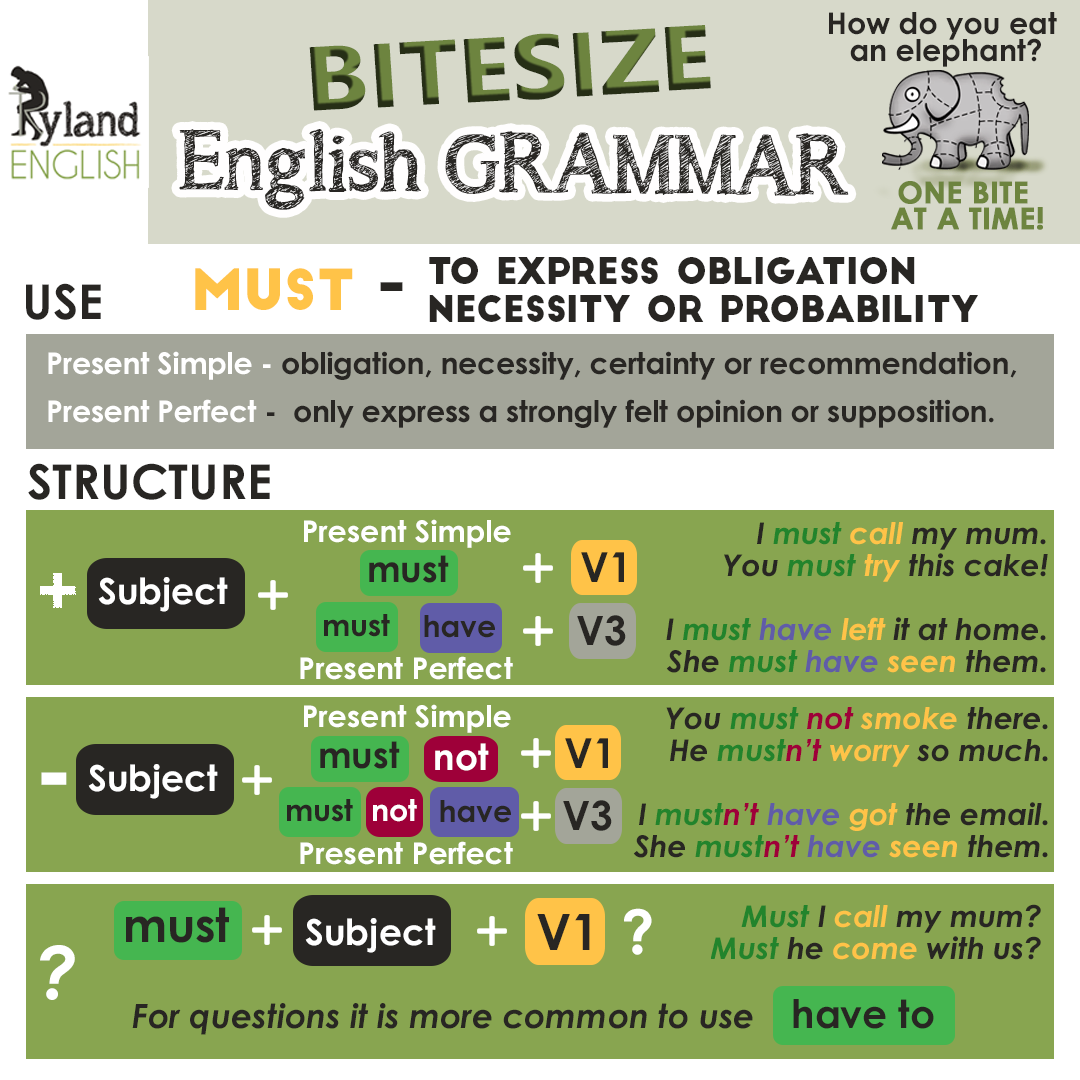
Another bit of English Grammar – Modals… they are everywhere!
A modal is a type of auxiliary (helping) verb that on its own has no meaning. It only adds meaning to the main verb, giving more details about the action.
They are really useful and express ideas like ability, permission, possibility, and necessity and most of them have more than one use… confusing, right?
But don’t worry, to help you remember we will explore when and how to use them in context… Ready?
MUST is a modal verb that expresses firm obligation, opinion, and recommendation, which is what this lesson is about. It is used to talk about actions and events in the PAST, PRESENT, or the FUTURE…

WARNING!!!
HAVE TO is also used to talk about firm obligation or opinion when you need to use tenses other than Present Simple or Present Perfect or when using questions.
How to use “MUST” in the PRESENT SIMPLE…
It can express obligation or necessity, this can be the need to do something to solve or avoid a problem as well as rules and laws.
Everyone must remain seated at all times.
We must get a permit to do that.
I must call my mother.
He must see the doctor!
It can also express certainty, strong probability or supposition, which is when you are sure that something is true because there is evidence to prove it.
It must be really cold outside. Look at the snow!
You still haven’t gone to bed? You must be tired!
I heard a noise, Jack must be home.
Mr Robertson is here; it must be Tuesday.
It can express a recommendation to do something you think is really good.
You must try this cake!
He must come to see the movie!
We really must get together for dinner sometime.
It can express a prohibition in the negative form, in other words, rules.
You mustn’t use your smartphone while you are driving.
You mustn’t get on the train without a ticket.
How to use “MUST” in the PRESENT PERFECT…
It is also used to talk about positive logical assumptions about things that happened in the past.
That must have been my mother calling me last night, nobody else has my number.
He must have won the lottery with the new house and car he has just bought.
She must have been at home – her car was there.
Differences between ‘MUST’ and ‘HAVE TO’
Must can be replaced by have to with little difference in meaning:
Have to is more informal while must is mostly used in written orders or instructions.
You have to be here on Monday.
You must resit the exam.
Must expresses obligation imposed by the speaker while have to refers to external obligation or an obligation on someone else.
Teacher; You must finish the essay by Monday.
Students; We have to finish the essay by Monday.
Matt has to finish the essay by Monday.
Had to is the past form of must for both obligation and probability.
You have to be here on Monday.
You must resit the exam.

WARNING!!
Be careful with the negative of must and have to where they DO have a different meaning.
mustn’t = it is prohibited; it is not allowed
don’t have to= no obligation; you are not required to do something, especially if you don’t want to.
HOW TO PUT IT TOGETHER TO MAKE SENTENCES?
This modal verb is made by using ‘must’ together with the base form [V1] for the PRESENT SIMPLE and ‘must have’ together with the past participle [V3] form for the PRESENT PERFECT.
Affirmative sentences
For sentences that are ‘positive‘ or affirmative, you can use ‘must’ and the V1 form or ‘must have’ and the V3 form. As simple as that! 👍

TOP TIP!! Must is used for all persons, including the third person singular!

He musts
She musts
It musts

He must
She must
It must
Negative sentences
For sentences that are ‘negative‘ you use the same components, must and the V1 form or must have/had and the V3 form, but you have to add the ‘not’ after must or between must and have.

TOP TIPS!!
‘Must not’ = ‘Mustn’t’
I must not forget to call my mother.
I mustn’t let that happen again.
Questions
For questions, you also use must and the V1 form, but you need to swap it 🔄 with the person/entity responsible for the action [the subject].

Generally, must is a very formal way to make a question so have to is used more often in normal conversation.
And that is it! It wasn’t too bad after all! 😎
Here you have some online games to help you practice what you have learnt! ENJOY!!
There is a nice collection of MUST exercises on this page!!
